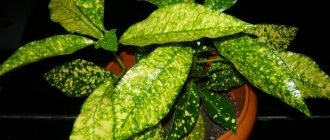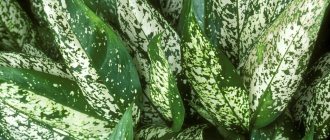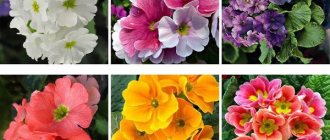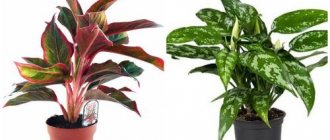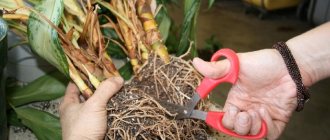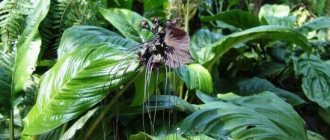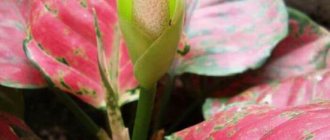By this time, Europeans had domesticated many different exotic plants that captured the imagination with their bright blooms or unusual appearance. The richness of tropical flora has invariably aroused the interest of botanists and gardeners, but what attracted them to Aglaonema?
Origin and appearance of aglaonema
Aglaonema is a perennial plant from Southeast Asia, it belongs to the genus of evergreen herbs and shrubs of the Araceae family. Aglaonema is widespread in India, China, Cambodia, Laos, Thailand, Vietnam, and Malaysia.
The first description of Aglaonema appeared in 1704. It was made by a Jesuit priest who lived in the Philippines. The original name Dracunculus did not stick, and in 1829 the plant received the name by which it is still known today - aglaonema - from the Greek words aglos - bright and nema - thread. The flower owes this name to the Austrian botanist Heinrich Wilhelm Schott, who devoted a lot of time to the study of aroids.
Aglaonema - decoration of any interior
In appearance, Aglaonema is very similar to Dieffenbachia, and this is not surprising, since they are close relatives.
Aglaonema is a small decorative foliage plant with a height of 30 to 80 cm with an erect trunk. However, it becomes noticeable only in mature plants, as the leaves die. In some species the trunk branches at the base. The leaves are on short or long petioles, dense, leathery, large. The shape of the leaves varies from elongated to broad oval. The midrib is depressed and clearly stands out on the bottom of the leaf. The leaves can be a variety of shades of green, depending on the variety, and are covered with silver, white, yellow and pink spots and veins. There are varieties with leaves of red shades .
The inflorescence of Aglaonema is a spadix with a pale green veil. 1 to 3 inflorescences develop in the axils of the upper leaves. The fruits are bright red, sometimes white, berries, several on the cob. They mature within 6–8 months.
Each Aglaonema berry contains one seed.
In nature, the habitat of Aglaonema is tropical and deciduous forests, wet plains, river banks and marshy peat deposits. Aglaonema is very hardy, able to grow in poor soils and tolerate lack of light. Thanks to these qualities, Aglaonema is considered an ideal plant for growing at home and in the office.
Aglaonema juice contains substances that irritate the skin. The seeds of the plant are also poisonous.
Conditions for the aglaonema plant
Aglaonema, as a resident of the tropics, prefers to stay in a warm room. If in summer the air temperature can vary from 21 to 26 °C, then in winter, when growth slows down a little, the plant is kept at 18–20 °C.
It is important that at any time of the year the air does not cool below 12–15 °C, since such temperatures can negatively affect the condition of the plant.
Particularly dangerous:
- draft and cold flow coming from windows or balconies;
- hot dry air from heating appliances.
Aglaonema's love for warmth also worries breeders. Therefore, when obtaining modern varieties and hybrids, special attention is paid to the plant’s ability to tolerate low temperatures. An example of such a variety is Silver Queen, an aglaonema plant with silver-green foliage that has earned an award from the Royal Horticultural Society for its decorativeness and hardiness.
In both winter and summer, aglaonema requires long daylight hours, at least 11–15 hours. By forcing a green pet to grow with a lack of light, you can cause it to become overly elongated, and:
- internodes lengthen;
- the foliage becomes smaller and loses its decorative effect;
- Aglaonema plants absorb moisture and mineral supplements more slowly.
Although aglaonemas are shade-tolerant, variegated plants need diffused light to maintain the brightness and color quality of their leaves. In summer, at midday, pots with aglaonemas are shaded, protected from direct rays, and in winter, artificial lighting is provided if necessary.
Watering plants varies depending on the time of year, air temperature and the condition of the plant. In warm weather, the soil needs to be moistened more abundantly than in winter or late autumn. If the room is cool, then the amount of water is also reduced. At the same time, you should not be guided by the widespread but erroneous opinion about the unconditional love of moisture of all people from the tropics. Aglaonema can more easily tolerate dry soil than constant waterlogging.
For irrigation, you need to take only settled warm water. And the substrate in a pot with aglaonema must be allowed to dry to a depth of 2–4 cm between waterings. Aglaonema responds well to irrigation with water and washing the foliage with warm water. This procedure helps:
- restore the attractiveness of foliage by cleaning it from dust;
- protect the plant from insect pests;
- ensure the respiration of aglaonema;
- increase air humidity.
We must not forget that aglaonema requires regular feeding during the growing season. They are carried out from early spring until October, using compositions for decorative foliage crops.
Popular varieties with different leaf colors
This plant appeared in greenhouses and homes in Europe in 1885. Books on floriculture of those times described the difficulties of maintaining the plant - it required high humidity and regular spraying. But the interest in aglaonema was so great that a large number of unpretentious hybrid varieties were subsequently developed.
There are about 50 species of aglaonema in nature. And the number of hybrids bred today is approaching 500.
Silver Queen . One of the most common Aglaonema hybrids, it was bred in the 60s of the 20th century. The length of the leaves reaches 15 cm, and the width is 8 cm. The color of the leaves is smoky-silver with a few green splashes. Very easy to care for, prefers partial shade. The bush usually reaches 70–80 cm in height.
Silver King . Just as easy to care for as the variety described above, but shorter. The color of the leaves and cuttings is silver-gray.
Crete . The variety belongs to the group of red aglaonemas. The plant is slow growing. The color of the leaves changes with age. If young leaves are completely red, then as they grow, spots appear on them, ranging in color from rich green to olive. This variety is very demanding on lighting. In a darkened room, the leaves lose their bright color and glossy shine. It reaches a height of 30–40 cm.
Aglaonema modest . The variety has good shade tolerance. The leaves are rich green in color, about 20 cm long. The plant reaches a height of 50 cm.
Treiba . It is considered the most unpretentious variety. A low bush with narrow leaves about 15 cm in length, covered with a silver-green pattern.
Maria . The most popular variety of aglaonema, which is more than 50 years old. A very shade-tolerant plant, it can grow even in rooms with artificial lighting. The lush bush reaches a height of 50 cm. The leaves are ellipsoidal, green with silver spots.
Aglaonema curly. This is a large - up to 120 cm in height - plant with a vertical stem. The leaf blade is semicircular, up to 30 cm long and 16 cm wide. The color of the leaves is silver-matte, with the exception of the middle and edge of the leaf blade.
Siam Aurora . Another representative of the red group. Unpretentious, grows quickly. With additional lighting, the leaves become brightly colored. In the sun it “fades”: red colors darken, and green colors become yellow.
Photo gallery: Crete, Maria, Treiba and other popular varieties of aglaonema
Aglaonema Siam Aurora
Aglaonema curly
Aglaonema Maria
Aglaonema Treiba
Aglaonema Modest
Aglaonema Crete
Aglaonema Silver King
Aglaonema Silver Queen
Description
Aglaonema modesta is distinguished by beautiful dark green fleshy leaves ranging in size from 10 to 20 centimeters and bright red fruit berries. This species is native to the Philippines and Sulawesi.
Aglaonema modest reaches a height of about 40-50 centimeters, no more. It belongs to the medium-sized aglaonemas. It grows slowly, only about 5-6 new leaves appear on the plant per year. This herbaceous plant is an evergreen crop. The leaves are very dense, smooth to the touch, and are attached to the base of the stem with virtually no stem.
This plant is often confused with Dieffenbachia due to their external similarity. The main difference between Aglaonema and its counterpart Dieffenbachia is that Aglaonema grows much more slowly and is not as demanding in terms of lighting. Another difference from Dieffenbachia is its narrower leaves. In addition, Dieffenbachia grows much larger than aglaonema.
Care
Place
Do not place aglaonema in direct sunlight, as this may result in leaf burn. Partial shade is ideal. For varieties with variegated leaf colors, bright, diffused light is preferable.
In winter, it is worth additionally highlighting the plants, because aglaonema needs light for 12–15 hours during the day.
The place where aglaonema grows must be protected from drafts and tobacco smoke. The plant loves clean air. Aglaonema will feel good in a ventilated room, but it is better not to place it in the kitchen.
Watering and fertilizing
For the good development of aglaonema, the correct watering and feeding regime is important. This plant is moisture-loving, so in spring and summer we generously water our pet. But most importantly, don’t overfill it. Do not allow water to stagnate in the pan. After watering, the water should be completely absorbed into the soil. The next watering is carried out when the top layer of soil is slightly dry . You can understand when the time for watering has come by probing the soil to a depth of 5 cm. If the soil is dry, water it; if it is wet, postpone watering. In the fall, before the onset of cold weather, we water abundantly, but as the temperature drops, we reduce watering. In winter, watering is carried out after the earthen clod dries.
Water for irrigation is used soft, room temperature, settled. In winter, it is better to heat the water slightly.
During the growing season from March to August, fertilizing is done once every two weeks. Mineral fertilizers alternate with organic ones. In autumn, the growth of aglaonema slows down and feeding is reduced. In winter there is a period of rest - fertilizing is not needed during this period.
Aglaonema does not like lime fertilizers.
Differences in care during flowering and dormancy
Under natural conditions, aglaonema blooms from June to August. Making aglaonema bloom is very simple. To do this, you need to create good conditions for it: a wide and shallow pot, regular spraying and watering, a comfortable temperature in the room without sudden fluctuations.
To speed up flowering, you can include bone meal in the fertilizing.
The aglaonema flower is not of particular decorative value and many gardeners remove it, especially on young plants. You can leave the peduncle: sometimes self-pollination occurs and fruits are set. If this does not happen, then after the flower dries, it must be carefully cut off. But if you prefer the decorative qualities of foliage, then it is best to remove the flowers: flowering contributes to the shrinkage of the leaves.
Aglaonema flowers are not particularly decorative
Like most house plants, the dormant period for aglaonema occurs in winter . During this period, the active growth of the plant slows down. The periods between watering increase, feeding stops altogether. We maintain high humidity and spray the plant with slightly warm water.
If the air temperature in the room does not drop below 20 degrees, aglaonema may not go into “winter mode”.
Table: seasonal care for aglaonema at home
| Season | Watering | Lighting | Humidity | Air temperature | Top dressing |
| Spring |
|
| It is necessary to regularly spray and wash the plant. | 20–25 degrees. | Lime-free complex fertilizers for indoor plants - every 2 weeks. |
| Summer | |||||
| Autumn | Carefully spray the flower with warm water. |
| Feeding is reduced. | ||
| Winter |
|
| The flower is not fed. |
Aglaonema leaves should never be treated with sprays to add shine. It is enough to simply wash them regularly with water at room temperature.
Caring for aglaonema at home
The decorative appearance of aglaonema can only be achieved by creating comfortable living conditions. The flower is unpretentious and responds gratefully to the care of its owner.
Lighting
In tropical forests, the plant chooses shaded corners hidden under the canopy of trees. Therefore, they also try to grow cultivated species of aglaonema in partial shade. When exposed to direct sunlight, foliage runs the risk of serious burns. Variegated varieties are bred in conditions of bright but diffused light. Otherwise, the perennial will gradually lose its decorative properties.
The shade-loving plant Aglaonema readily grows on north-facing window sills and in the interior of rooms, especially since caring for it is not burdensome.
Temperature
In summer, aglaonema develops normally if the air temperature is from 20 to 25 degrees. Hotter weather negatively affects the condition of the vegetative parts. During the winter months, the temperature should not fall below 16 degrees. Drafts and sudden cold weather can lead to the death of the plant. Like other representatives of aroids, the flower negatively perceives sudden changes in weather and fluctuations in the thermometer.
Watering mode
To water aglaonema, it is recommended to pre-settle the water to reduce its hardness. Rain and melt water are excellent. Re-wetting is carried out as the upper part of the soil dries. The need for water increases in the spring and summer. At this time, the plant experiences activation of all life processes. In winter, at least 3-4 days should pass between the next watering, otherwise the top earthen lump will not have time to dry properly.
Disease and death of a perennial can be caused by drying out the soil and overwatering the roots. When moistening the substrate, moderation should be observed.
Humidity level
Aglaonema needs high humidity. The leaves need to be sprayed frequently to prevent the tips from drying out. And, conversely, in a room where the humidity is too low, the growth of leaf plates will be slow. They become deformed and turgor pressure decreases. To regulate the humidity levels in the room, you need to install a tray with expanded clay and pour some water into it. Place a flower pot on top.
At the end of the summer season, when the temperature drops noticeably, the above-ground parts of the bush are sprayed extremely carefully
It is important not to allow moisture to accumulate at the bottom of the pot. In this case, the root system will soften and soon become ill.
Mold and fungal diseases are the main problems that gardeners encounter when growing aglaonema.
The soil
When choosing soil for growing aglaonema, they give preference to humus, leaf soil, sand, charcoal and peat. The proportion of these components is 1:6:2:2:1. Or you can replace the soil mixture with leaf soil (2 parts), peat (1 part) and sand (1 part). To increase the breathability of the substrate, add a handful of crushed charcoal. It is possible to avoid the accumulation of liquid in the flowerpot after watering using a drainage layer.
Aglaonema can grow hydroponically. This method allows you to grow a flower not in the ground, but in water or a nutrient solution, where the roots of the plant are immersed.
Feeding
While the plant is overwintering, the soil is no longer enriched with fertilizers. Feeding of aglaonema is organized only with the first warmth of spring. Fertilizers are applied from March to August every 2 weeks. It is advisable to combine organic and mineral fertilizers. The nutrient solution is diluted according to the instructions on the manufacturer's label.
Transfer
Young aglaonema plants are replanted once a year. Preferably in the spring. Overgrown flowers are much less likely to be disturbed. It is enough to replant once every 4-5 years.
How to transplant a flower correctly
Young aglaonema is replanted annually in the spring. An adult plant feels great in a cramped pot when the root system is limited, so replanting is done every 2–5 years, but as necessary, replace the top layer of soil with a new one. To do this, carefully remove about 2 centimeters of old soil and add new soil.
The ideal soil for planting would be a mixture of 3 parts leaf soil, 2 parts peat, 1 part humus and 1 part sand. Aglaonema prefers loose, uncrowded soil with good air and water permeability.
We pay special attention to the planting pot. Aglaonema has a superficial and fibrous root system, so a deep pot is undesirable. We will give preference to a wide one, taking into account the appearance of new young plants, and a shallow one. Aglaonema grows better if its roots are limited to a small space. When choosing the size of a planting pot, keep in mind that approximately a quarter of its volume will be taken up by drainage.
- Pour a layer of drainage into the selected pot: small pebbles, broken shards or expanded clay.
Drainage is necessary to avoid stagnation of water in the root system.
- Fill the prepared soil to approximately half the volume.
- Carefully straightening the roots, place the aglaonema in the center of the pot.
- We fill up the soil. If the plant is young, then it does not need to be buried. An old plant with a bare trunk can be slightly buried.
- After planting, water the aglaonema abundantly.
Store-bought aglaonema is not immediately replanted. She is given 2 to 3 weeks to adapt, and then transplanted, observing all the rules listed above .
Aglaonema also grows well in a nutrient solution without soil - hydroponics.
Planting and transplanting
Soil and pot
The main requirement for a substrate for growing aglaonema is lightness and friability. Ready-made soil can be purchased in specialized stores or you can make it yourself. Among the optimal soil mixture options are the following:
- Store-bought substrate for Aroids.
Ready-made substrate for Aroniaceae - suitable soil for aglaonema
- A mixture based on porous leaf soil (3 parts) with humus (1/2 part), sand (1 part), peat (1 part) and charcoal (1/2 part).
- Composition of leaf soil (2 parts), moss (1/3 part), peat (1 part), sand (1 part) and charcoal (1/2 part).
- A soil mixture of leaf soil (2 parts), peat (1 part) and sand (1 part).
- Hydroponics is a nutrient-rich solution without soil.
Hydroponics - an alternative to conventional soil
For aglaonema, a plant with a fibrous root system, a shallow pot that is significantly wider at the top is best suited. Its size depends on the age of the flower. However, there is a general rule - you need a fairly dense placement of the roots
It should be taken into account that approximately a quarter of the volume must be left for drainage.
Drainage
Aglaonema needs good drainage. It should provide increased air exchange and water permeability. Expanded clay, broken ceramics or small crushed stone cope well with these functions.
Expanded clay is an excellent drainage material that should occupy 1/4 of the pot
Transfer
This procedure is carried out annually for a young plant. In the future, transplantations are advisable once every 3–5 years. A signal for this is the “bulging” of roots to the surface or through the drainage hole of the pot, as well as disease, deformation or damage to the plant. The most painless method of replanting for a plant is transshipment, which preserves the earthen lump and does not damage the roots of the flower.
Droplets, brown spots and other problems
Table: errors in care and their elimination
| Problem | Cause | Elimination |
| The leaves dry out and become brittle. | The room is too dry and hot. | Transfer the plant to a ventilated area, wipe the leaves with a damp cloth, and spray. |
| The edges of the leaves began to turn yellow. | Watering is done with hard chlorinated water. | Leave the water for at least a day before watering. |
| The edges of the leaves have become limp. | Excessive or insufficient watering. | Dig the soil in the pot to see if the soil is dry enough before the next watering. |
| Droplets appeared on the leaves. |
|
|
| Leaves lose color and yellow spots appear. | Possible burns from direct sunlight. | Remove aglaonema from direct sun. |
| The leaves began to shrink. | Most likely a lack of nutrients. | Feed the plant. |
| Curled leaves with brown edges. | Too cold air or drafts. | Remove the aglaonema to a warmer room without drafts. |
Table: diseases and pests of aglaonema
| Problem | Symptoms | Control and prevention |
| Gray rot | Gray, sometimes brown spots appear on the leaves and stem, soft to the touch. They spread quickly throughout the plant. |
|
| Rust | A fungal disease in which orange “velvet” pads appear on the underside of the leaf and golden spots on the top. | Remove the affected parts of the flower and pollinate the plant with ground sulfur. |
| Mealybug | The leaves become distorted, dry out and fall off. White, fluffy, cotton-ball-like pests can be seen on stems, leaves and in their axils. | Actellik, Fitoverm, Fazol - apply strictly according to the instructions, using protective measures (gloves, gauze bandage). |
| Aphid | The leaves curl, dry out, and fall off. Aphids are located on the lower part of the leaf and are clearly visible. |
|
| Spider mite | The lower part of the leaf is covered with thin threads resembling a cobweb with whitish dots. The mite sucks the juices from the plant. |
|
| Thrips | Dry spots or streaks appear on the leaves. The leaf becomes deformed and falls off. | Remove the top layer of soil to a depth of 3–5 cm, wipe the aglaonema with a soap solution. After 4–5 hours, spray with Fitoverm. |
| Whitefly | The lower leaves become covered with a sticky coating. Small white insects living under the leaves are visually noticeable. |
|
| Shchitovka | Brown tubercles on the leaves and stem of aglaonema. Scale insect larvae can attract sooty fungus. | Scale insects are removed mechanically using a damp cloth soaked in a weak soap solution. Every 3-4 days the procedure must be repeated until the scale insects completely disappear. |
Pests and diseases
Aglaonema is very rarely affected by pests. To carry out preventive measures, spray the plant with a weak solution of insecticide from time to time.
- The edges of the leaves have turned brown. If the edges of the leaves of your aglaonema have acquired an unsightly brown color, this means that the indoor plant urgently needs watering and air humidification. To eliminate the problem, carefully remove dry fragments. After this, spray the plant with water from a spray bottle and do this regularly. Place the container with the plant on a tray with wet pebbles or expanded clay.
- The leaves are withering. As a rule, the leaves wither due to keeping aglaonema in the cold or exposure to drafts. Place the pot in a warm place away from drafts.
How can aglaonema reproduce?
Reproduction of aglaonema does not present any particular difficulties. There are three ways: seeds, cuttings and root division. Aglaonema is not propagated by leaves.
Seeds
This method is suitable for those gardeners who love surprises. The fact is that plants grown from seeds often do not resemble their parents. You can collect seeds only when they are easily separated from the fruit at the slightest touch. If you need to make an effort when extracting the seeds, it means they are not yet ripe . Seeds must be planted immediately.
The longer you wait to plant the collected seeds, the less likely they are to germinate.
Process description:
- A mixture of peat and river sand in equal proportions is poured into wide flat pots or boxes; sphagnum moss is also suitable.
- The seeds are not deeply buried - a maximum of 1.5 centimeters into moist soil.
- The planting container is covered with polyethylene or glass.
- Every 2-3 days the soil is sprayed with a spray bottle.
- Under favorable conditions, the first shoots appear after 3 months.
- After a pair of true leaves appear, the aglaonema can be transplanted into a separate pot.
Plants grown from seed are usually vigorous but grow slowly. Varietal characteristics are almost never preserved. This is especially true for highly decorative varieties bred through selection.
Cuttings
As cuttings, you can use apical, lateral shoots of aglaonema or parts of the bare trunk of an adult plant that have growing points . The length of the cutting should be at least 3–5 centimeters, and the presence of at least one leaf guarantees almost 100% rooting.
Rooting parts of the trunk can be done all year round, but it is best to do this in March-April.
- Powder the chopped parts of the trunk with crushed activated carbon and dry for a day.
- We lightly press a piece of the trunk into the wet substrate, if it is small, and if the piece is larger, we deepen it vertically to the growth point.
- Cover with a plastic bag and place in a warm, bright place.
- The temperature should be from +24 to +26 degrees. You need to ventilate the cuttings once a day, slightly lifting the bag. Keep the soil moist.
- In a month, roots will appear.
Rooting part of the trunk is a fairly effective way to propagate aglaonema
Rooting of apical or lateral shoots occurs as follows:
- We cut off the shoots and tie the leaves on them into a bundle to reduce moisture evaporation.
- We dip them for a few minutes in a solution of Epin or Zircon for better root formation (you don’t have to do this, aglaonema usually takes root well without this procedure).
- Sprinkle the sections with crushed activated carbon and dry for 8 hours.
- Prepare the pot: pour drainage and soil in half with sand. We moisturize well.
- Using a pencil or stick, make a hole in the ground.
- We plant the cutting to the base of the leaf, compacting the soil around it.
- Using a frame and cellophane we make a greenhouse.
- Place in a warm, bright place. Ventilate periodically.
- Don't forget to moisten the soil as it dries.
- In a month, the aglaonema will have a root system.
Rooting apical and lateral shoots is one of the most popular methods of propagating aglaonema
You can root apical cuttings and side shoots simply in water with the addition of growth stimulants (Zircon, Epin). Dip the cutting into the solution and place it in a warm and bright place. The water needs to be changed every 3-4 days. In direct sunlight the water may turn green.
Dividing rhizomes
An adult, heavily grown plant, which is divided into several bushes, is best suited for this method.
- Remove the aglaonema from the pot.
- Shake off excess soil and wash the roots in water.
- Using a sharp knife or scissors, separate the young shoots with a formed root system.
The plant to be separated must have at least 3 leaves.
- Sprinkle the cut areas with activated carbon, crushed into powder.
- Immediately plant the separated shoot in a pot prepared in advance and water well.
- Place in a warm place for a week. Spray periodically.
- When a young leaf appears on the aglaonema, which indicates normal rooting, place the pot with the plant in a permanent place.
Dividing the rhizome of aglaonema during transplantation is the easiest method of propagation
6. Transplantation of aglaonema
Replant as necessary - about once every three years , since the plant grows rather slowly.
Don't use a pot that's too big—aglaonema grows best when its root system is cramped .
Try not to disturb the root system again and use transshipment along with a lump of earth.
When transplanted, adult plants that form a trunk are placed horizontally - at the same time, dormant buds wake up on the stem and each of them forms its own leaves. As a result of this procedure, you can get a chic, lush plant.
Planting in fresh soil is carried out in the spring , when the plant wakes up and demonstrates its readiness to develop.
↑ Up,
Reviews
A relative of Dieffenbachia, the plant Aglaonema, came to me several years ago. <…> Over the course of several years, the plant grew longer and the color became less variegated, so I grew a new one from a tip cutting, which was not difficult to do. I like this indoor flower because it does not require special care, effectively purifies indoor air, and reduces the content of harmful substances that enter the apartment.
tamarav https://spasibovsem.ru/responses/rodstvennitsa-diffenbahii.html
I really like Aglaonemas for their unpretentiousness and variety of colors. For about two years I tried to root several different varieties. Unfortunately, they didn't want to grow. She fed, sprayed, tried to find the most suitable place. Everything was useless. I decided to tackle the root system. For six months I watered it with Ribav and Zircon (to form a root system). The result was not long in coming.
irulchik https://myfl.ru/category/nazvanie-rasteniya/aglaonema
My aglaonemas appeared not so long ago, but the red color is completely preserved. I think that in good lighting conditions it will not disappear. Shrinking of leaves, disappearance of variegation - these are similar to signs of insufficient lighting. In my opinion, red aglaonema, like its less colorful relatives, is a very unpretentious plant. It has a lot of advantages - it tolerates overdrying, low humidity, heat and at the same time does not dry out the tips of the leaves and retains an attractive appearance. In general, I am a fan of this plant, like all others with beautiful leaves.
Vanda https://flo.com.ua/forum/viewtopic.php?t=17400
Reproduction of aglaonema by seeds
Planting aglaonema with seeds is painstaking and difficult work. If you succeed, then only after 3-4 years you will get beautiful, formed plants, and before that they will more closely resemble separately growing leaves. But if your aglaonema yielded a fruit in the form of a berry, then why not try this method of propagation?
- Wait until the fruit ripens and begins to wrinkle - this indicates that the seed can be used.
- Take out the seed, peel it from the pulp, rinse well under running water.
- The fruit must be planted immediately, as it quickly loses its ability to germinate! Mix sand and peat in a 1:1 ratio and plant the seed.
- Water the planting well and place the container in a warm place.
- The first shoots should appear quickly. When the plant produces real leaf blades, you will need to plant it in a pot with soil, the mixture for which we discussed above (section “Transplanting”).
Problems during cultivation
Quite often, when caring for aglaonemas, gardeners are faced with problems such as yellowing or wilting of foliage, and the appearance of dry spots on the leaves. There can be many reasons for this:
Knowing how to care for aglaonema at home, you can grow a lush plant from a small bush that will decorate a green corner in an apartment or house with its beautiful decorative leaves.
The Aglaonema plant is a member of the aroid family. This genus includes about 20–50 species. The plant is naturally found in the rain forests of tropical New Guinea, the Malay Archipelago, as well as in Southeast Asia along river banks in the lower forest belts and plains.
Peculiarities
In addition to being highly decorative, the plant brings significant benefits:
- cleans and humidifies the air in the room;
- absorbs toxic substances from gas combustion;
- has disinfecting properties;
- kills anaerobic bacteria;
- increases resistance and general immune properties of the body;
- enriches the air with air ions;
- has a positive effect on the functioning of the nervous system and overall well-being.
Features of the Aglaonema flower.
The juice and fruits of aglaonema are poisonous, so you should not touch the plant with your bare hands, and if there are small children and pets in the apartment, you must place the pot out of reach.
Most varieties of aglaonema feel good and grow at home, and with minimal simple care, this unpretentious decorative foliage flower can become a real decoration for the interior of a living room or office.

